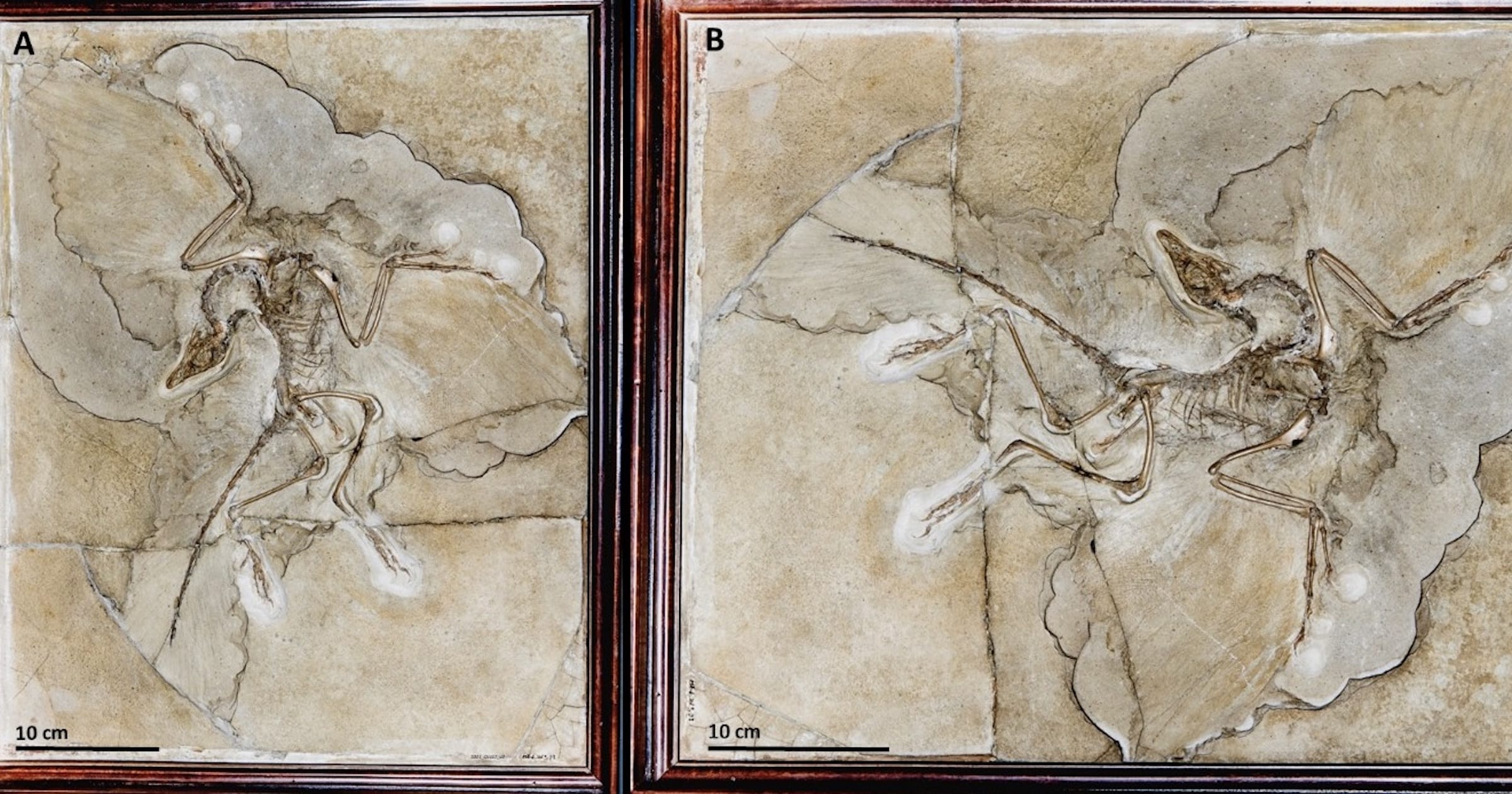 Evolution
Evolution
 Paleontology
Paleontology
Fossil Friday: Imagining Eggs in the Famous Archaeopteryx Fossils

This Fossil Friday I could not resist discussing a paper (Guimarães 2023) that I recently stumbled upon. It is still in preprint stage at bioRxiv and has not undergone peer review. I definitely hope that it will not survive peer review as it easily qualifies as the most ridiculous piece of garbage science I ever came across. The author is Portuguese computer scientist Jorge Guimarães, who apparently lacks any expertise in paleontology or geology. His paper has been heavily promoted on social media by his medical software company, ALERT Life Sciences, claiming that the “Mona Lisa of fossils was rediscovered” and promising a “paradigm shift in evolution,” “following what is arguably the biggest fossil rediscovery of all time.” The same institution also published nothing short of a three volume book by Guimarães (2018) on the “ground breaking findings.” This sounds like something really interesting and unusual.
So What Did He Find?
The author maintains that:
Since 1877, researchers have missed the fact that Archaeopteryx, the icon of evolution and the Mona Lisa of fossils, was nesting over more than one hundred jellybean-like soft eggs and hatchlings.
Following what is arguably the biggest fossil rediscovery of all time, can you imagine the day when museums around the world will make the decision to change the display position of this fossil to reflect its nesting posture?
A paradigm shift in evolution starts with the change in the display position of Archaeopteryx and extends into the evolution of reproduction in animals, the evolution of wings and flight, attention to fossil sediment instead of just bones, and new perspectives on mass extinctions, among others.
When you look carefully at the images in the preprint paper it is quite clear why scientists have “overlooked” these hundreds of eggs and hatchlings in five different fossil specimens of Archaeopteryx, including the name-giving isolated feather: there is simply nothing there at all, but just a random pattern of stone matrix. At work apparently is some kind of pareidolia effect, where people erroneously believe they see things like a human face in random places where there isn’t anything. The author also seems to be ignorant of the multiple lines of taphonomic evidence (see Arratia et al. 2015: 78–100) that strongly contradict his hypothesis that the fossil preservation of bird nests with adults still sitting in breeding position on eggs and hatchlings can be explained by the occasional flooding of colonial ground nesting sites on the shore of the Upper Jurassic Solnhofen lagoon.
Did the author find any hard evidence of egg shells apart from his Rorschach-test-like identification of alleged shapes of eggs? Something like microstructure or chemical composition of the eggshells? Nothing at all. His excuse is that the specimens were not available for such studies, because access to the original specimens was denied to him or the potentially invasive studies were not authorized by the museum curators.
This is still more problematic because there is considerable evidence that, even though the first dinosaurs had soft eggs, hard-shelled eggs belong to the ground plan of theropod dinosaurs and birds (Norell et al. 2020). The author’s claim of non-rigid eggs in Archaeopteryx would therefore strongly conflict with the consensus phylogeny. And we have not even mentioned yet that the supposed eggs are much too small and too numerous for an ancient bird of the size of Archaeopteryx, or that a preservation in nesting position is inconceivable unless you assume that the animals miraculously did not bother to make a move while being flooded.
Not a Good Combination for Science
However, neither lack of evidence nor conflicting evidence stopped the author from drawing far-reaching conclusions, based on the hypothetically assumed colonial ground nesting behavior, such as an evolution of bird flight from ground-up rather than tree-down, and an origin of wings and feathers for breeding purposes rather than locomotion. Both views may or may not be correct, but they are certainly not supported by the highly controversial evidence presented by the author. But I can hardly blame him for his act of creative imagination, because that is what much of mainstream evolutionary biology is all about anyway.
The author first presented his “sensational” results on September 18, 2019, at the annual conference of the Paläontologische Gesellschaft in Munich, Germany. I don’t know what the reaction of the experts was at this event (I would bet on embarrassed silence and some good laughs), but apparently they could not convince him to reconsider his maverick interpretation. One could easily brush aside this case as an extreme exception produced by an incompetent non-expert in a non-peer-reviewed medium. But unfortunately this case is rather symptomatic of a general trend in modern paleontology towards overinterpreting, overhyping, and overselling poor fossil evidence. The reason seems to be a combination of publish-or-perish pressure, pressure by PR departments to oversell results in pursuit of renewed public grants, and the career incentive to push evolutionary scenarios and just-so stories with fossil data as supposedly hard evidence. Not exactly a good combination for the advance of science.
References
- Arratia G, Schultze HP, Tischlinger H & Viohl G (eds) 2015: Solnhofen – Ein Fenster in die Jurazeit. 2 vols. Pfeil Verlag, Munich (DE), 620 pp. https://pfeil-verlag.de/publikationen/solnhofen-ein-fenster-in-die-jurazeit/
- Guimarães MJ 2023. Colonial ground nesting by Archaeopteryx suggests wing evolution in primal association with nesting and the ground up evolution of flight. bioRxiv. DOI: https://doi.org/10.1101/2023.05.30.542892
- Norell MA, Wiemann J, Fabbri M, Yu C, Marsicano CA, Moore-Nall A, Varricchio DJ, Pol D & Zelenitsky DK 2020. The first dinosaur egg was soft. Nature 583, 406–410. DOI: https://doi.org/10.1038/s41586-020-2412-8
